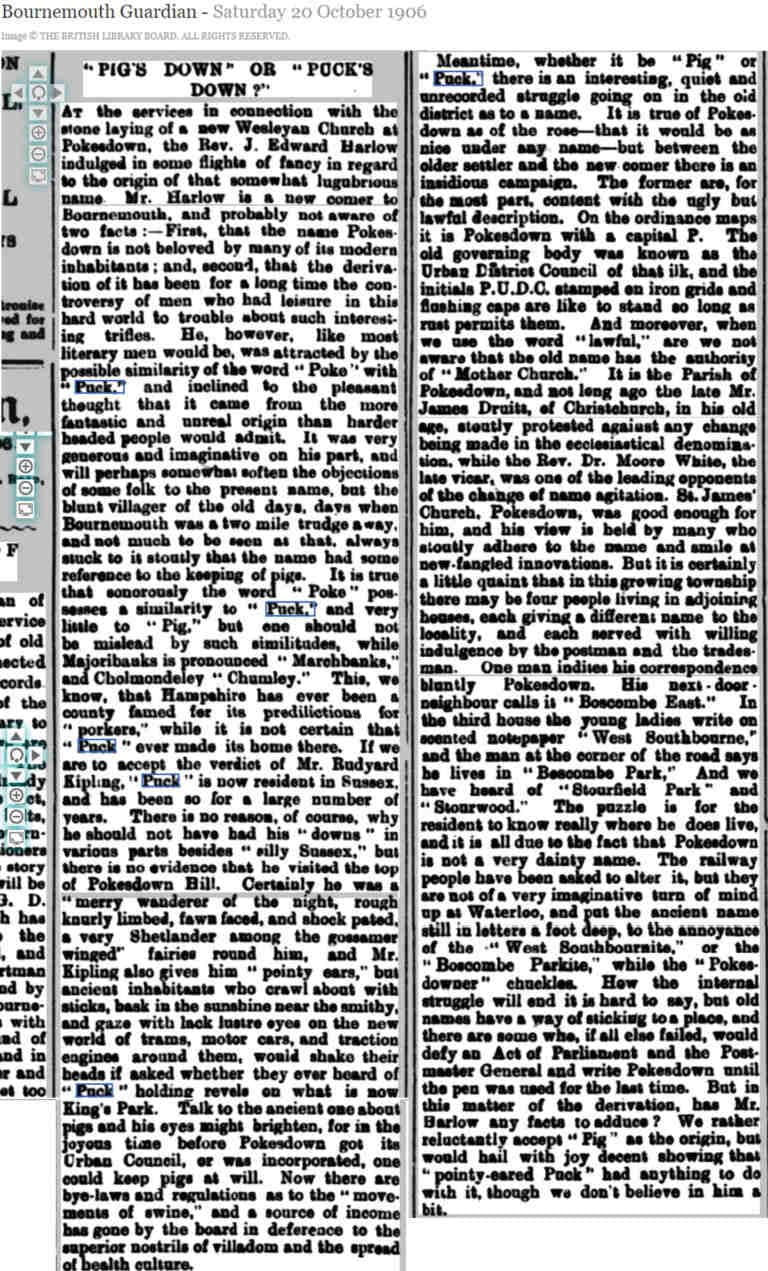But why would people be “seeing”, or thinking about, pixies/puck/pooka specifically in Pokesdown??!
Being “pixie-led” (or “piskie-led”) refers to being mis-led, lost in familiar surroundings, losing time, never arriving at your destination. Such as what happens if you spot a light in the dark of night, somewhere there are no sources of manufactured light about, and head towards it, thinking the light is guiding you to a safe place…. But the light keeps moving, and in trying to follow it, you end up more lost than ever.134a
I feel like I’m being pixie-led, trying to back-trace the stories behind the theories of the origins of the name “Pokesdown” following paths here, there, and everywhere, and never reaching a definitive conclusion!
Those wispy lights, spotted on commons and moors at night, are thought to be the product of gases produced by organic decay, and this is not a “modern” interpretation. In 1596 Ludwig Lavater wrote a chapter called “many naturall things are taken to be ghoasts” which included reference to Willo-the-Wisps.134b “Visual and perceptual illusions of motion”134c also need to be factored in.
In Welsh folklore, this “fairy fire” is carried by a puca; in the Devon and Cornwall traditions the “pixie light” is carried by a pixie.134b The 19th century-coined serious term for this phenomena is “Ignis Fatuus” which is Latin for “Fool’s Fire”.134c

Jefferey Lindell at the Indiana University Folklore Institute has compiled a list of names used to describe this same thing, and just in English there are 250 of them! They include: Will-o’-the-wisp; Kitty with the wisp; Kitty Candlestick; Jack-o’-lantern; Hob-with-a-lantern; Hob Puck; Devil’s lantern; and all of the pixie and puck variations.134c
A Pokesdown local, farmer Richard Dale, who was born in 1794, recorded his memories in the booklet Reminiscences of Stourfield – Stourfield being an early part of the development of Pokesdown. In Reminiscences he says about seeing134d
“what was commonly called Kit Candlesticks” which he had the good sense not to try and follow “as I have been told by many they had been led into difficulties and lost their way from attempting to follow, supposing that they were going in the direction of some house. Many people were kept riding about all night after them.”
I haven’t found a Bournemouth or Christchurch newspaper reference to Kit Candlesticks, but I did find an 1847 Wilts & Gloucestershire Standard article, quoting a description from 1691:134e
“Ignis fatuus, called by the vulgar Kit of the Candlestick, is not very rare on our downs about Michaelmas.”
The 1847 journalist then adds his own note to the end of this: “These ignes fatui, or Jack-o’ lanthorns, as they are popularly called, are frequently seen in low boggy grounds. In my boyish days I was often terrified by stories of their leading travellers astray, and fascinating them.- J.B.”
To know that “Ignis Fatuus” was a familiar enough sight in the Pokesdown area for it to have a name it was commonly known by – “Kit Candlesticks” – adds credence to the theory of “Pokes-“ coming from puca/pixie/puck.
The Complete Book of Devils and Demons has these notions mixed-in together in its introduction to Minor Supernatural Creatures of Britain:134f
Puck, Robin Goodfellow, Queen Mab, Tom Thumb, and many equally fanciful creatures who have not been given personal names, such as Kit with The Candlestick, Hop o’My Thumb, bugs, bogeymen, bull- beggars, fetches, sylens, firedrakes, pookas …. The pooka in Mary Chase’s play Harvey is a six-foot rabbit invisible to everyone except Elwood P. Dowel and a fine farce it makes. Some of these creatures were considered malicious, some not.
An alternative explanation for the association with fairies or pixies is, as Calkin explains, the theory that
“fairy tales are often based on ‘folk memories’ concerning some previous race which has since disappeared. It is therefore possible that the name [Pokesdown] preserves an ancient tradition about the very people whose graves have come to light during this present century” – by which he means the Bronze Age burials discovered in the Pokesdown area in the first half of the twentieth century.134g
In 1906 Rudyard Kipling published a book called “Puck of Pook’s Hill”!135 I wonder if that, in part, helped cement the connection in people’s minds between “Pokesdown” and pixies/fairies?! A Bournemouth Guardian article from 1906 mentions this book, locals bumpy relationship with the name “Pokesdown”, and a theory that the name was something to do with “pigs”:
A PDF of the newspaper articles is available here. They are images, and not plain text, but they can be enlarged for easier viewing this way.

David Young concludes:
“Pokesdown” is a name of doubtful origin… Examples of earlier uses or forms of “Pokesdown” would help toward a more definite pronouncement but in the meanwhile the name should be treasured as one of the few within the borough boundary which long ante-date enclosure.136
The copy and paste citation for this page:
The History of Rosebery Park Baptist Church and Pokesdown – Pokesdown: the name, Page 2. Author: Michelle Fogg. Date: May 2022. Url: https://roseberypark.org/history/pokesdown-the-name-2/
Sources of Information for The History of Rosebery Park and Pokesdown (opens in new tab)
Go To About Us
Go to Other Activities
Rosebery Park Baptist Church, 812-814 Christchurch Road, between Boscombe and Pokesdown, Bournemouth, BH7 6DF
